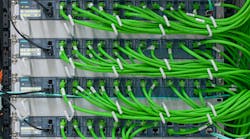Traditional industrial I/O cabinets play a crucial role in manufacturing environments, serving as the nerve center for communication among various field devices and the control system.
These cabinets have a centralized design, where I/O modules live in one location. This centralized location means space inside the cabinet can come at a premium, especially when new technology or machines require substantial expansion or new modules.
One prominent aspect of these setups is the reliance on long cable runs to connect field devices to the central cabinet. Centralization results in complex and extensive wiring, increasing installation time and leading to high labor costs.
See also: The Crystal Ball Report 2024: A preview podcast
The need for specialized cabling also poses challenges in terms of maintenance, as identifying and addressing issues within the lengthy cable network can be time-consuming. Additionally, the space requirements for centralized I/O cabinets can be substantial, occupying valuable floor space within industrial facilities. As manufacturing environments evolve and space becomes a premium, the large footprint of these cabinets can become a limiting factor.
Installation time is critical in industrial settings, where minimizing downtime is crucial for operational efficiency. Traditional centralized I/O cabinets often require meticulous planning and extended installation periods, leading to potential disruptions in production schedules when machines are installed or upgraded. Maintenance of centralized setups can be challenging due to the sheer complexity of the wiring and the centralized nature of the system.
See also: Production planning: How AI can help meet every delivery deadline
Identifying and troubleshooting issues may involve significant downtime, impacting overall productivity and increasing costs. As industries seek more agile and modular solutions, there is a growing trend toward decentralized I/O architectures that offer flexibility, reduced cable lengths, easier maintenance, and more efficient use of space.
Optimizing efficiency with machine-mount I/O
Decentralized I/O isn’t as simple as attaching I/O cabinets to machines. Machine-mounted I/O systems are subject to demanding environments, including vibrations, heat, water, oil, airborne particulates, or other substantial challenges. To be reliable, distributed machine-mounted I/O systems must allow for rugged use.
See also: SI introduces Great Question: A Manufacturing Podcast
Similarly, to deliver efficiency and broad compatibility in various applications, machine-mounted I/O needs an open architecture that enables it to work with a full range of protocols (e.g., PROFINET, Modbus TCP, EtherNet/IP), and analog as well as digital modules. Modularity, open architecture, and the flexibility to be multifunctional help to standardize machine design and ensure distributed I/O systems are compatible with varied applications.
The extensive wiring inherent in centralized systems makes identifying and addressing faults time-consuming, leading to prolonged downtimes during troubleshooting. Moreover, the centralized nature of I/O cabinets concentrates potential points of failure, amplifying the impact of any issues that may arise. In contrast, distributed I/O systems with shorter cable runs and decentralized modules offer quicker fault detection and isolation, minimizing downtime and enhancing overall production efficiency in dynamic industrial environments.
Distributed I/O systems make error diagnosis a user-friendly procedure integrated into the system. The efficient fault analysis and fast troubleshooting speed up commissioning and minimize production downtimes.
Even minor cost savings in I/O can translate into substantial overall expense reductions across the entire facility over time. By employing decentralized modules, shorter cable runs and more flexible installations, expenses related to cabling, installation time and maintenance decrease. These seemingly modest savings accumulate plantwide, leading to significant operational cost reductions.
See also: How to make the shift from passive to active energy management
Additionally, the inherent flexibility and scalability of distributed I/O systems allow for efficient adaptation to changing production needs, further optimizing resource utilization and enhancing the long-term cost-effectiveness of industrial operations.
Machine-mounted I/O delivers substantial advantages plantwide:
- Simplified engineering with standardized modules
- Reduced commissioning time
- Substantial reductions in cabling and central cabinet space requirements
- Streamlined fault detection and reduced downtimes
- Less maintenance cost overall
The modern digital factory has outgrown centralized I/O systems. The I/O cabinets from legacy plant designs have necessitated extensive and expensive cable runs, costly maintenance and substantial difficulties associated with fault detection and resolution.
Distributed machine-mount I/O streamlines the expansion or installation of machines and can reduce overall cost and commissioning time for new machines or greenfield plants. The small individual cost savings of machine mount I/O solutions are substantial when scaled plantwide. Overall, distributed I/O reduces cost and downtime while increasing efficiency.



